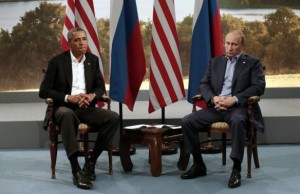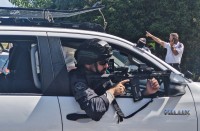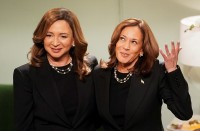By David Rohde and Arshad Mohammed

Credit: Reuters/Kevin Lamarque/Files
WASHINGTON AND NEW YORK Fri Apr 18, 2014 3:00pm EDT
(Reuters) – In September 2001, as the U.S. reeled from the terrorist attacks on the World Trade Center and the Pentagon, Vladimir Putin supported Washington’s imminent invasion of Afghanistan in ways that would have been inconceivable during the Cold War.
He agreed that U.S. planes carrying humanitarian aid could fly through Russian air space. He said the U.S. military could use airbases in former Soviet republics in Central Asia. And he ordered his generals to brief their U.S. counterparts on their own ill-fated 1980s occupation of Afghanistan.
During Putin’s visit to President George W. Bush’s Texas ranch two months later, the U.S. leader, speaking at a local high school, declared his Russian counterpart “a new style of leader, a reformer…, a man who’s going to make a huge difference in making the world more peaceful, by working closely with the United States.”
For a moment, it seemed, the distrust and antipathy of the Cold War were fading.
Then, just weeks later, Bush announced that the United States was withdrawing from the Anti-Ballistic Missile Treaty, so that it could build a system in Eastern Europe to protect NATO allies and U.S. bases from Iranian missile attack. In a nationally televised address, Putin warned that the move would undermine arms control and nonproliferation efforts.
“This step has not come as a surprise to us,” Putin said. “But we believe this decision to be mistaken.”
The sequence of events early in Washington’s relationship with Putin reflects a dynamic that has persisted through the ensuing 14 years and the current crisis in Ukraine: U.S. actions, some intentional and some not, sparking an overreaction from an aggrieved Putin.
As Russia masses tens of thousands of troops along the Russian-Ukrainian border, Putin is thwarting what the Kremlin says is an American plot to surround Russia with hostile neighbors. Experts said he is also promoting “Putinism” – a conservative, ultra-nationalist form of state capitalism – as a global alternative to Western democracy.
NOT PAYING ATTENTION?
It’s also a dynamic that some current and former U.S. officials said reflects an American failure to recognize that while the Soviet Union is gone as an ideological enemy, Russia has remained a major power that demands the same level of foreign policy attention as China and other large nations – a relationship that should not just be a means to other ends, but an end in itself.
“I just don’t think we were really paying attention,” said James F. Collins, who served as the U.S. ambassador to Moscow in the late 1990s. The bilateral relationship “was seen as not a big deal.”
Putin was never going to be an easy partner. He is a Russian nationalist with authoritarian tendencies who, like his Russian predecessors for centuries, harbors a deep distrust of the West, according to senior U.S. officials. Much of his world view was formed as a KGB officer in the twilight years of the Cold War and as a government official in the chaotic post-Soviet Russia of the 1990s, which Putin and many other Russians view as a period when the United States repeatedly took advantage of Russian weakness.
Since becoming Russia’s president in 2000, Putin has made restoring Russia’s strength – and its traditional sphere of influence – his central goal. He has also cemented his hold on power, systematically quashed dissent and used Russia’s energy supplies as an economic billy club against its neighbors. Aided by high oil prices and Russia’s United Nations Security Council veto, Putin has perfected the art of needling American presidents, at times obstructing U.S. policies.
Officials from the administrations of Presidents Bush and Barack Obama said American officials initially overestimated their potential areas of cooperation with Putin. Then, through a combination of overconfidence, inattention and occasional clumsiness, Washington contributed to a deep spiral in relations with Moscow.
COMMON CAUSE
Bush and Putin’s post-2001 camaraderie foundered on a core dispute: Russia’s relationship with its neighbors. In November 2002, Bush backed NATO’s invitation to seven nations – including former Soviet republics Estonia, Latvia and Lithuania – to begin talks to join the Western alliance. In 2004, with Bush as a driving force, the seven Eastern European nations joined NATO.
Putin and other Russian officials asked why NATO continued to grow when the enemy it was created to fight, the Soviet Union, had ceased to exist. And they asked what NATO expansion would do to counter new dangers, such as terrorism and proliferation.
“This purely mechanical expansion does not let us face the current threats,” Putin said, “and cannot allow us to prevent such things as the terrorist attacks in Madrid or restore stability in Afghanistan.”
Thomas E. Graham, who served as Bush’s senior director for Russia on the National Security Council, said a larger effort should have been made to create a new post-Soviet, European security structure that replaced NATO and included Russia.
“What we should have been aiming for – and what we should be aiming for at this point,” Graham said, “is a security structure that’s based on three pillars: the United States, a more or less unified Europe, and Russia.”
Graham said small, incremental attempts to test Russian intentions in the early 2000s in Afghanistan, for example, would have been low-risk ways to gauge Putin’s sincerity. “We never tested Putin,” Graham said. “Our policy never tested Putin to see whether he was really committed to a different type of relationship.”
But Vice President Dick Cheney, Senator John McCain and other conservatives, as well as hawkish Democrats, remained suspicious of Russia and eager to expand NATO. They argued that Moscow should not be given veto power over which nations could join the alliance, and that no American president should rebuff demands from Eastern European nations to escape Russian dominance.
DEMOCRACY IN OUR TIME
Another core dispute between Bush and Putin related to democracy. What Bush and other American officials saw as democracy spreading across the former Soviet bloc, Putin saw as pro-American regime change.
The 2003 U.S. invasion of Iraq, without U.N. authorization and over the objections of France, Germany and Russia, was a turning point for Putin. He said the war made a mockery of American claims of promoting democracy abroad and upholding international law.
Putin was also deeply skeptical of U.S. efforts to nurture democracy in the former Soviet bloc, where the State Department and American nonprofit groups provided training and funds to local civil-society groups. In public speeches, he accused the United States of meddling.
In late 2003, street protests in the former Soviet republic of Georgia, known as the Rose Revolution, led to the election of a pro-Western leader. Four months later, street protests in Ukraine that became known as the Orange Revolution resulted in a pro-Western president taking office there.
Putin saw both developments as American-backed plots and slaps in the face, so soon after his assistance in Afghanistan, according to senior U.S. officials.
In 2006, Bush and Putin’s sparring over democracy intensified. In a press conference at the first G-8 summit hosted by Russia, the two presidents had a testy exchange. Bush said that the United States was promoting freedom in Iraq, which was engulfed in violence. Putin openly mocked him.
“We certainly would not want to have the same kind of democracy as they have in Iraq,” Putin said, smiling as the audience erupted into laughter, “I will tell you quite honestly.”
Bush tried to laugh off the remark. “Just wait,” he replied, referring to Iraq.
A PITSTOP IN MOSCOW?
Graham said the Bush administration telegraphed in small but telling ways that other foreign countries, particularly Iraq, took precedence over the bilateral relationship with Moscow.
In 2006, for example, the White House asked the Kremlin for permission for Bush to make a refueling stop in Moscow on his way to an Asia-Pacific summit meeting. But it made clear that Bush was not looking to meet with Putin, whom he would see on the sidelines of the summit.
After Russian diplomats complained, Graham was sent to Moscow to determine if Putin really wanted a meeting and to make clear that if there was one, it would be substance-free.
In the end, the two presidents met and agreed to ask their underlings to work on a nonproliferation package.
“When the Russian team came to Washington in December 2006, in a fairly high-level … group, we didn’t have anything to offer,” Graham said. “We hadn’t had any time to think about it. We were still focused on Iraq.”
Graham said that the Bush administration’s approach slighted Moscow. “We missed some opportunities in the Bush administration’s initial years to put this on a different track,” Graham said. “And then later on, some of our actions, intentional or not, sent a clear message to Moscow that we didn’t care.”
THREE TRAIN WRECKS
Bush’s relationship with Putin unraveled in 2008. In February, Kosovo unilaterally declared independence from Serbia with the support of the United States – a step that Russia, a longtime supporter of Serbia, had been trying to block diplomatically for more than a decade. In April, Bush won support at a NATO summit in Bucharest for the construction of a missile defense system in Eastern Europe.
Bush called on NATO to give Ukraine and Georgia a so-called Membership Action Plan, a formal process that would put each on a path toward eventually joining the alliance. France and Germany blocked him and warned that further NATO expansion would spur an aggressive Russian stance when Moscow regained power.
In the end, the alliance simply issued a statement saying the two countries “will become members of NATO.” That compromise risked the worst of both worlds – antagonizing Moscow without giving Kiev and Tbilisi a roadmap to join NATO.
The senior U.S. official said these steps amounted to “three train wrecks” from Putin’s point of view, exacerbating the Russian leader’s sense of victimization. “Doing all three of those things in kind of close proximity – Kosovo independence, missile defense and the NATO expansion decisions – sort of fed his sense of people trying to take advantage of Russia,” he said.
In August 2008, Putin struck back. After Georgia launched an offensive to regain control of the breakaway, pro-Russian region of South Ossetia, Putin launched a military operation that expanded Russian control of South Ossetia and a second breakaway area, Abkhazia.
The Bush administration, tied down in Iraq and Afghanistan, publicly protested but declined to intervene militarily in Georgia. Putin emerged as the clear winner and achieved his goal of standing up to the West.
ONLY ONE MAJOR ISSUE
After his 2008 election victory, Barack Obama carried out a sweeping review of Russia policy. Its primary architect was Michael McFaul, a Stanford University professor and vocal proponent of greater democracy in Russia who took the National Security Council position previously held by Thomas Graham.
In a recent interview, McFaul said that when Obama’s new national security team surveyed the administration’s primary foreign policy objectives, they found that few involved Russia. Only one directly related to bilateral relations with Moscow: a new nuclear arms reduction treaty.
The result, McFaul said, was that relations with Moscow were seen as important in terms of achieving other foreign policy goals, and not as important in terms of Russia itself.
“So that was our approach,” he said.
Obama’s new Russia strategy was called “the reset.” In July 2009, he traveled to Moscow to start implementing it.
In an interview with the Associated Press a few days before leaving Washington, Obama chided Putin, who had become Russia’s prime minister in 2008 after reaching his two-term constitutional limit as president. Obama said the United States was developing a “very good relationship” with the man Putin had anointed as his successor, Dmitry Medvedev, and accused Putin of using “Cold War approaches” to relations with Washington.
“I think Putin has one foot in the old ways of doing business and one foot in the new,” Obama said.
In Moscow, Obama spent five hours meeting with Medvedev and only one hour meeting with Putin, who was still widely seen as the country’s real power. After their meeting, Putin said U.S.-Russian relations had gone through various stages.
“There were periods when our relations flourished quite a bit and there were also periods of, shall we say, grayish mood between our two countries and of stagnation,” he said, as Obama sat a few feet away.
At first, the reset fared well. During Obama’s visit, Moscow agreed to greatly expand Washington’s ability to ship military supplies to Afghanistan via Russia. In April 2010, the United States and Russia signed a new START treaty, further reducing the U.S. and Russian nuclear arsenals. Later that year, Russia supported sweeping new U.N. economic sanctions on Iran and blocked the sale of sophisticated, Russian-made S-300 anti-aircraft missile systems to Tehran.
Experts said the two-year honeymoon was the result of the Obama administration’s engaging Russia on issues where the two countries shared interests, such as reducing nuclear arms, countering terrorism and nonproliferation. The same core issues that sparked tensions during the Bush administration – democracy and Russia’s neighbors – largely went unaddressed.
A VAPORIZED RELATIONSHIP
In 2011, Putin accused Secretary of State Hillary Clinton of secretly organizing street demonstrations after disputed Russian parliamentary elections. Putin said Clinton had encouraged “mercenary” Kremlin foes. And he claimed that foreign governments had provided “hundreds of millions” of dollars to Russian opposition groups.
“She set the tone for some opposition activists, gave them a signal, they heard this signal and started active work,” Putin said.
McFaul called that a gross exaggeration. He said the U.S. government and American non-profit groups in total have provided tens of millions of dollars in support to civil society groups in Russia and former Soviet bloc countries since 1989.
In 2012, Putin was elected to a third term as president and launched a sweeping crackdown on dissent and re-centralization of power. McFaul, then the U.S. ambassador in Moscow, publicly criticized the moves in speeches and Twitter posts.
In the interview, McFaul blamed Putin for the collapse in relations. McFaul said the Russian leader rebuffed repeated invitations to visit Washington when he was prime minister and declined to attend a G-8 meeting in Washington after he again became president. Echoing Bush-era officials, McFaul said it was politically impossible for an American president to trade Russian cooperation on Iran, for example, for U.S. silence on democracy in Russia and Moscow’s pressuring of its neighbors.
“We’re not going to do it if it means trading partnerships or interests with our partners or allies in the region,” McFaul said. “And we’re not going to do it if it means trading our speaking about democracy and human rights.”
Andrew Weiss, a Russia expert at the Carnegie Endowment for International Peace, said that clashes over democracy ended any hopes of U.S.-Russian rapprochement, as they had in the Bush administration.
“That fight basically vaporizes the relationship,” said Weiss.
In 2013, U.S.-Russian relations plummeted. In June, Putin granted asylum to National Security Agency whistleblower Edward Snowden. Obama, in turn, canceled a planned summit meeting with Putin in Moscow that fall. It was the first time a U.S. summit with the Kremlin had been canceled in 50 years.
Last fall, demonstrators in Kiev began demanding that Ukraine move closer to the European Union. At the time, the Obama White House was deeply skeptical of Putin and paying little attention to the former Soviet bloc, according to Weiss. White House officials had come to see Russia as a foreign policy dead end, not a source of potential successes.
Deferring to European officials, the Obama administration backed a plan that would have moved Ukraine closer to the EU and away from a pro-Russian economic bloc created by Putin. Critics said it was a mistake to make Ukraine choose sides.
Jack F. Matlock, who served as U.S. ambassador to Moscow from 1987 to 1991, said that years of escalating protests by Putin made it clear he believed the West was surrounding him with hostile neighbors. And for centuries, Russian leaders have viewed a friendly Ukraine as vital to Moscow’s defense.
“The real red line has always been Ukraine,” Matlock said. “When you begin to poke them in the most sensitive area, unnecessarily, about their security, you are going to get a reaction that makes them a lot less cooperative.”
A PLIANT RUSSIA?
American experts said it was vital for the U.S. to establish a new long-term strategy toward Russia that does not blame the current crisis solely on Putin. Matthew Rojansky, a Russia expert at the Wilson Center, argued that demonizing Putin reflected the continued failure of American officials to recognize Russia’s power, interest and importance.
“Putin is a reflection of Russia,” Rojansky said. “This weird notion that Putin will go away and there will suddenly be a pliant Russia is false.”
A senior U.S. official, who spoke on condition of anonymity, called for a long-term strategy that exploits the multiple advantages the U.S. and Europe enjoy over Putin’s Russia.
“I would much rather be playing our hand than his over the longer term,” the official said. “Because he has a number of, I think, pretty serious strategic disadvantages – a one-dimensional economy, a political system and a political elite that’s pretty rotten through corruption.”
Matlock, the former U.S. ambassador, said it was vital for Washington and Moscow to end a destructive pattern of careless American action followed by Russian overreaction.
“So many of the problems in our relationship really relate, I would say, to what I’d call inconsiderate American actions,” Matlock said. “Many of them were not meant to be damaging to Russia. … But the Russian interpretation often exaggerated the degree of hostility and overreacted.”
(Edited by John Blanton)








